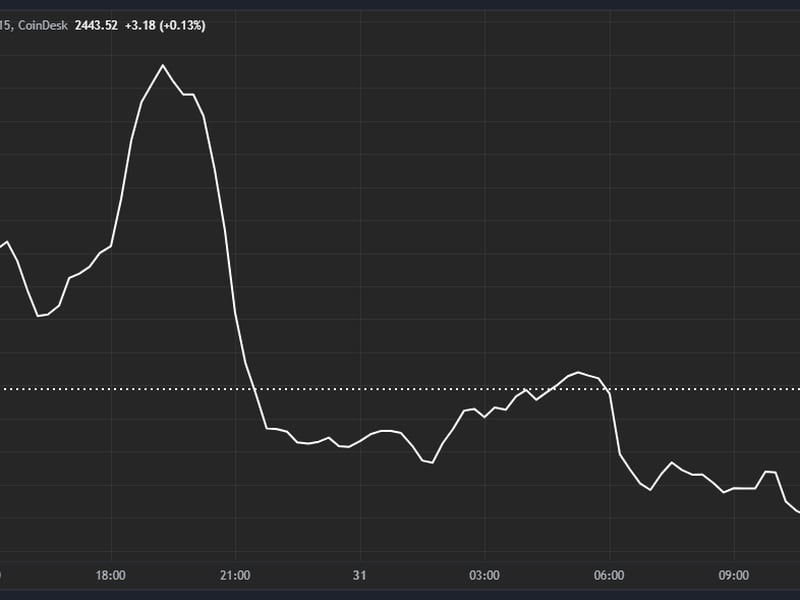From Crypto Winter to DeFi: A Year of Loss and Opportunity

Michael J. Casey is the chairman of CoinDesk’s advisory board and a senior advisor for blockchain research at MIT’s Digital Currency Initiative.
The following article originally appeared in Consensus Magazine, a custom-curated magazine delivered exclusively to Consensus 2019 attendees.
Whatever transpires at this year’s Consensus conference, it’s safe to say it will be nothing like last year’s.
In May 2018, a number of crypto millionaires chose Consensus and New York Blockchain Week to show the fruits they’d taken from a crazy price bubble that ended four months earlier. Though they represented a small minority of attendees, their ostentatious displays of Lamborghinis and decadent all-night boat parties had an outsized influence on how observers perceived the tone of the event.
I for one am relieved that this year’s conference will surely be a more subdued affair.
It means we can discuss protocol developments, new applications, business models and regulatory actions in a setting that lets the mainstream media focus on the topic at hand, without falling for the voyeuristic distractions of a “Housewives of Crypto” show playing in the wings.
In fact, if we use the past two Consensus events as bookends for a 12-month review, we can look back on the past year – dubbed by many as the “Crypto Winter” – and satisfyingly conclude that it also included some impressive progress in blockchain evolution.
The post-bubble mantra was “BUIDL, not HODL,” and it seems this call to arms was taken seriously by “builders” in the crypto community. A year that marked the 10-year anniversary of the launch of bitcoin was as exciting as any other in the short but action-packed world of cryptocurrencies and blockchain technology.
Learning from mistakes
This is not to say it wasn’t a tough year.
As bitcoin’s price collapsed from its lofty peak of $19,783 in December 2017 to a low of $3,122 a year later, as ether retracted 94 percent peak-to-tough, and as countless ERC-20 tokens that were issued in the prior two years plunged to near worthlessness, the crypto community came under a barrage of criticism.
Some of it was justified – one research paper suggested that more than two-thirds of initial coin offerings (ICOs) were scams. But at times the mainstream criticism during the downturn was as extreme as the crypto hype had been during the bubble period. The economist Nouriel Roubini made an art form out of his profanity-laced attacks on all things and all people associated with the sector.
Sadly, headlines around both ICOs and poorly managed cryptocurrency exchanges last year often reinforced this all-too-common misconception of the technology and its advocates as farce.
In November, the SEC fined boxer Floyd Mayweather and DJ Khaled for not disclosing that they’d been paid to promote an ICO by a company called Centra Tech, whose founders were indicted for fraud. Throughout the year, questions were constantly raised about whether Tether, the stablecoin used by numerous exchanges to manage their crypto and fiat floats, was sufficiently backed by reserves to sustain its one-to-one peg to the dollar.
And later in 2018, the collapse of Canadian exchange QuadrigaCX, which lost $190 million of customer funds after its founder, Gerald Cotten, died in India, spawned a cottage industry of conspiracy theories on Twitter and Reddit. But there was a silver lining to these failures. They encouraged developers to devise solutions to them.
Most importantly, one of the industry’s most nagging problems is on the verge of being solved: the risk of relying on third-party custodians to carry out asset exchanges. In 2018, the first decentralized exchanges (DEXs) emerged based on “atomic swap” technology, which uses smart contracts and multi-signature (multisig) technologies to enable seamless, peer-to-peer asset exchanges without any one party having control of both assets at any time. Binance, the new king of crypto exchanges, is now testing a decentralized version of itself.
Meanwhile, Boston startup Arwen announced in January that its technology will enable traders to use regular centralized exchanges to find buyers or sellers for their crypto assets while maintaining full control over their private keys. Similar technologies also underpin the Cosmos project, which launched its system for decentralized, cross-chain exchanges of digital assets in March. Along with alternatives such as Polkadot and Ripple’s Interledger, Cosmos promises deeper pools of liquidity and scalability as it achieves interoperability across different blockchain ecosystems.
And with tokenization innovators seemingly unfazed by the ICO flame out, the past year also saw a flurry of new methods for creating new representations of value to move across these decentralized systems.
Tokens not dead
Consider the surging interest in non-fungible tokens. Unlike, say, a bitcoin or a dollar, which is fungible, or perfectly substitutable for any other bitcoin or dollar, each NFT is unique.
It means that, for the first time, we have a collectible, provably scarce “thing” of digital value. Made popular by the 2017 launch of CryptoKitties – a series of breeding, collectible colorful cats built on the Ethereum ERC-721 standard – NFTs hit their stride last year as businesses such as gaming companies saw opportunities for trading virtual goods online.
MLB Champions, for example, launched a game with Major League Baseball-licensed collectible digital figurines. There were also some innovative uses of NFTs for charity, for rewarding environmental actions and as loyalty points. Later in the year, Cryptokitties founder Dapper Labs tapped $15 million in funding from VCs including Andreessen Horowitz and Venrock.
Then there was another three-letter acronym: STO – security token offering. With the SEC determining that most, if not all, ICOs were unregistered securities, a lot of the fundraising efforts gravitated to STOs. These deliberately self-identified as securities subject to regulatory control, which meant they can’t be sold to the general public without meeting the SEC’s various reporting and other requirements.
STOs don’t make the same revolutionary claims as the ICO boom’s “utility token” purveyors – that their tokens aren’t an investment, but a kind of pre-sold “fuel” that organically regulates a decentralized network. (The SEC wasn’t convinced: it argued that pretty much all ICOs were securities, at least at the moment of sale.) There’s no such fancy “crypto-economics” behind STOs. Nonetheless, they have the capacity to significantly disrupt capital markets.
STOs armed with smart contracts could facilitate automatic, fully reconciled updates of share registries in both primary and secondary markets. They could render traditional book-runners such as underwriters obsolete and allow issuers to fractionalize ownership of the assets to tiny stakes. And they’ve opened people’s minds to the breadth of assets that could be securitized: everything from real-estate and accounts receivable to intellectual property and even rare art.
Lightning
To some crypto enthusiasts, the regulator-friendly STO movement is a let-down from the radical ideas behind ICOs, which promised to disintermediate and democratize venture capital.
But there was plenty going on elsewhere last year to sustain the community’s revolutionaries. Importantly, we saw the serious launch of the Lightning Network, the off-chain payment channel solution to the scaling challenges at bitcoin and other cryptocurrencies, which many see as the ideal “Layer 2” route to achieving Satoshi Nakamoto’s vision of digital cash. A testing version of Lightning formally went live on the bitcoin mainnet in early 2018. Since then the network has grown to encompass around 8,000 nodes and almost 40,000 channels.
To function at scale, this nascent community must grow out a network of interlinking channels – essentially, it must build an economy from scratch. It’s an experimental process, one helped this year by the “Lightning Torch,” a social media-fueled game in which people passed around a small but ever-growing pool of bitcoin via Lightning channels.
Members of the bitcoin breakaway community behind Bitcoin Cash (now itself split into competing forked currencies) mocked Lightning torch carriers for sometimes struggling to find liquid open channels for otherwise small transactions, implying that Bitcoin Cash’s core on-chain feature – bigger blocks – better fulfills “Satoshi’s vision” of peer-to-peer payments than Lightning’s off-chain approach.
It’s too early to know whether Lightning will succeed, but at least this process will let us work with data instead the wild rhetoric that has until now passed for argument between bitcoin’s feuding factions.
Meanwhile, among other altcoins, concerns were raised about 51% attacks. The massive, post-bubble drop in market prices drove miners of many coins to stop using their ASIC rigs. This drove down rental rates for mining equipment, make it comparatively much cheaper to get a majority of the hashing power and engineer a “deep reorg” of old blocks, enabling fraudulent double-spend actions.
The price drop made fraud affordable, which spelled trouble for various proof-of-work blockchains: Bitcoin Gold, Vertcoin, Flo and, the big one, Ethereum Classic.
Again, however, these attacks encouraged positive technological development, in this case to find additional security against double-spends. New approaches included the Komodo Platform’s use of bitcoin’s more reliable security as a backstop to the altcoin’s native consensus security, and a plan proposed by Flo developers to enlist the user base to automatically rent hashing power and offset an attacker. The industry was showing, once again, that what doesn’t kill you makes you stronger.
Stablecoins and DeFi
The past year was also the year of the stablecoin, where digital tokens are offered by an entity that pegs their value to some other asset, typically dollars. There was a crying need for cryptocurrency exchanges to use an alternative to Tether. But, more importantly, many see trusted stablecoins as the missing piece for enterprise blockchain applications that use fiat-currency mediums of exchange, such as in supply chain management.
These innovations could add a real-time, volatility-free payment rail to systems that until now relied on the friction-filled banking system for settling cash transfers.
Last year, Gemini, Paxos, a venture-backed startup called TrustToken, and a consortium founded by Circle and Coinbase all launched stablecoins that back every token issued with a dollar stored in reserves. Each submitted to being heavily regulated and argued that because the funds are stored inside banks insured by the Federal Deposit Insurance Corporation, users have peace of mind that their tokens can be redeemed and, by extension, that their one-to-one peg will hold.
Trading in these stablecoins is growing rapidly, but they may face competition from alternatives backed by corporates that leverage giant user bases to create network effects: JP Morgan’s JPM Coin, for example, as well as a widely anticipated offering from Facebook.
For crypto purists who point to persistent crises in the banking system as a reminder of the risks of third-party backers, these reserve systems are all flawed. The alternative, some argue, is for algorithmic stablecoins. This is not easy to achieve, partly because hackers could build competing algorithms to put algorithmic stablecoins’ smart contracts under stress. Nonetheless, a number of complex math solutions are giving it a shot.
One early offering, Basis, disbanded in December as its model, which involved the automatic issuance of interest-earning “bonds” to regulate monetary supply, faced insurmountable regulatory hurdles. But the one that has caught everyone’s attention is Dai, the stablecoin at the heart of MakerDAO, the Ethereum-based cryptocurrency credit project.
MakerDAO is more than a stablecoin project. It’s generating crypto-collateralized loans and has given rise to the fascinating new world of decentralized finance, or #DeFi. Along with the “staking as a service,” in which custodians essentially pay their clients interest on coins that are used to seek block rewards in the validation of proof-of-stake blockchains, #DeFi is giving shape to an unchartered system of new money creation on top of a base cryptocurrency infrastructure. It portends huge potential for frictionless financial access – as well as undeniable risks, with parallels being drawn to systemic crises in traditional finance.
Who knows where it all goes. Either way, it will no doubt provide great fodder for the 2020 Consensus year in review.
Time image via Shutterstock










